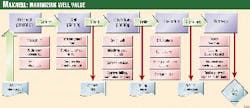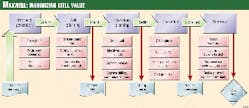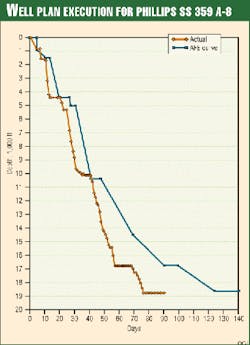To ensure that exploration wells deliver maximum value, Phillips Petroleum Co., Bartlesville, Okla., has developed MaxWell ("Maximize Well Value"), a set of well-management processes and tools designed to guide well planning, drilling, evaluation, and completion.
The program is designed to establish a more coordinated, successful effort by company exploration and drilling departments.
Too often, exploration prospects are simply passed to drilling departments that are expected pursue them with the information at hand.
Unfortunately, because of these informal hand-offs, drilling departments may end up with confusing objectives and a poor well design or over-design. The prospect may have a spud deadline or require a long lead-time for equipment or have been discussed only briefly in the last drilling coordination meeting.
The result can be a very expensive well, poor value to the company, and several authorization for expenditure (AFE) supplements to pay for the experience.
To combat this situation, the exploration for, and development of, oil and gas is evolving new planning and execution processes and subprocesses.
Teamwork
In 1997, a multidisciplinary team at Phillips of geoscientists, production, reservoir, drilling, research and development, information technology, and logistics professionals came together into a team.
This team was chartered to investigate both internal and external drilling and completion best practices; key planning and execution processes; and technological issues for the drilling, evaluation, and completions which would maximize capital expenditures for wells.
The result of this effort, MaxWell, encompasses five phases from prospect generation (concept) through the post analysis. To add maximum value, lessons learned are documented; experience from both successes and failures is transferred; and performance is accurately measured.
By identifying full-time and extended team members who will affect the outcome of the prospect, MaxWell specifies the competencies and structure of an integrated well team. Roles and responsibilities for every team member are clearly defined and documented. A team charter, prepared by the team, is negotiated, approved, and signed-off on by the prospect manager.
The team charter documents the team's purpose and scope and identifies the owner of the project (prospect). MaxWell includes resource management mechanisms to monitor human resource time and costs as well as to provide management status updates of the prospect in any phase.
Phases
MaxWell consists of five phases (Fig. 1):
In many cases, this phase initiates preliminary site reviews by the drilling and production departments to be assured that the potential location or locations do not necessitate safety or environmental delays.
Management approval to proceed with more-detailed planning of the prospect is detailed in the "Goforit" ("go for it") document. Goforit carries the prospect to the drilling department with clearly documented well goals linked directly to that business unit and Phillips' strategic plan.
Management sign-off of the Goforit initiates the next phase.
Keeping the well goals and objectives in the forefront, the team develops detailed drilling, reservoir evaluation, and completion and production facilities plans, each with associated time frames and costs that are later documented in an AFE.
A key element of this phase is open and honest communication between team members. Every element of the plan must be put on the table, documented in the planning agenda, and discussed.
In the well-planning phase, new technology and reservoir evaluation ideas are identified, evaluated, and documented. Also, organizational learning through the transfer of experience and ideas is discussed and applied where appropriate.
All key well subprocesses are identified, defined, and linked to key MaxWell tasks. Some obvious subprocesses that are contained in MaxWell are the design of the downhole completion assembly and the procurement of long lead items such as wellheads and tubulars.
In the case of development wells, a key subprocess is the design, procurement, and prefabrication of the surface production facilities. It is through the subprocesses linked to MaxWell that costs are reduced and cycle compression of the project occurs.
The output of the well-planning phase is the PlanIt document, which includes mechanical and technological risk analysis of the prospect. PlanIt is used to generate the composite AFE.
Approval of the AFE by management and partners moves the integrated well team to the next process phase.
If design, costs, procurement, safety, or environmental assessments significantly affect the original goals or objectives, MaxWell contains the flexible option called "Change of Plan" with a document called "Coplanit."
The operations planning team's first order of business is to analyze and document any change since the AFE approval date that could affect the original objectives of the well.
If changes in scope are required, the Coplanit is returned to the prospect manager for review and approval and, if required, partners' consent to the changes.
It is at this point that any re-evaluation of the prospect's viability would be in order. It may be prudent to cancel further planning and return the prospect to inventory for further geologic or reservoir study.
If the team determines, however, that there are no changes to the original Goforit and Planit documents, then the "Drillit" ("drill it") document is prepared.
Drillit is the output of the operations-planning phase and details the total drilling, well evaluation, and downhole completion plan for use by the well site team in the execution phase.
The well site team executes Drillit and MOPS, identifies and documents lessons learned, and provides process or project improvement suggestions.
During this phase, the well-site team also maintains the Sectional Scorecard. This scorecarding for each hole section ensures that the well-site team carefully documents the lessons learned from operations successes and failures.
In the future, we will know why we are doing a specific operation or using a piece of equipment. Similarly, other subprocesses such as the completion and surface facility installation are timed to be ready when the well is ready to produce.
In the case of new field discoveries, a much larger production project plan must be prepared to include an initial field development complete with gathering lines, tank batteries, metering stations, and sales pipeline.
In the offshore case, a platform design and properly sized production facilities would be developed in order for the prospect generation to initial production cycle to be fully compressed, thus maximizing well value early.
It is important to keep in mind that the MaxWell template requires the integrated team to plan for success regardless of the classification of the well. When the well is commissioned for production, suspended, or plugged and abandoned, the execution phase is complete and the output is the well.
The integrated team's work for this well is not finished, however, until "wrapup" is complete.
The team reviews the tasks and subprocesses in MaxWell to identify and document better ways to do the next well. The team's post analysis review identifies and documents for the next well what was learned.
The "output" of the wrapup Phase is the "PWR" with fully completed scorecard. Armed with the PWR, the team communicates lessons learned to other well teams and individuals throughout the company using the MaxWell website and makes improvements to the MaxWell templates themselves.
The integrated team transmits well planning and execution improvement suggestions for use by another integrated well team for the next well on the budgeted schedule.
Tools
The MaxWell template, consisting of five phases and 122 key project tasks, runs under the Windows 95, 98, or NT operating platform using Oil & Gas Consultants International's (OGCI) Organizational Learning Systems (OLS) desktop PC software package.
OLS enables links from MS Project to MS Access, MS Word, MS Excel, and MS PowerPoint software, offering a variety of methods to manage data, capture process improvements, and complete input and output and reference documents in MaxWell.
Typical reference documents are Phillips' casing and tubing design manual, Phillips' standard cementing design and cementing and squeeze operations manual, as well as Phillips' Drilling Practices Manuals and reference documents contained in the software associated with MaxWell.
To maximize task efficiency, MaxWell puts these references just a mouse click away. In addition, Phillips' exploration and production and corporate policies, such as safety, well control, environmental, procurement, contracting services, and AFE procedures are included as reference documents.
These reference documents are denoted as "Red Line" tasks, setting them apart from normal tasks. Thus, the integrated team stays focused on corporate roles and responsibilities during the planning and execution of the well.
Localization
The corporate MaxWell template is installed on each business unit's server (LAN: local area network). The integrated well teams then customize (localize) the corporate template to meet the demands of each well classification and geographical location and to meet the business unit's regulatory, environmental, and operational requirements.
For example, North America's MaxWell template for land operations is reasonably standard across the nation, but local reference documents for different states and counties need to be incorporated into the regional MaxWell templates.
These may include local regulatory policies, environmental regulations, and state surface and subsurface requirements for casings, mud disposal, and pit closures.
Another example of MaxWell localization is that the reference documents pertaining to the Gulf of Mexico federal (OCS) requirements for mobile offshore drilling units' (MODUs) mud discharges are included in the North America business unit's OCS MaxWell templates only.
At the same time, requirements for mud discharge or reinjection systems regulated in Norway would be included only in the Norwegian MaxWell template.
Customization or the inclusion of regional requirements is paramount to successful prospect planning and execution.
Benefits
MaxWell's primary benefit is assurance that Phillips Petroleum E&P remains competitive, linking objectives to business units' strategic plans, using "best practices," compressing project cycle time, allocating human resources more effectively, and maximizing the monetary value of the finished product.
Use of the process by the integrated well teams eliminates redundant tasks, captures and documents lessons learned, provides a guide for using best practices, maintains a "line of sight" to the objectives from concept through post analysis, provides adequate time and resources to plan, documents how to it was done right (or wrong), and measures the results against the well's objectives.
Gulf of Mexico experience
Since MaxWell/OLS templates have been regionalized to meet the local policies and regulatory requirements for planning and executing drilling and completion programs, the first well drilled with the new organizational learning system was on Phillips' Gulf of Mexico Mahogany subsalt prospect.
The original well plan of SS 359 A-8 resulted in achieving deviated total depth of 18,800 ft in 81 days vs. 124 planned (Fig. 2). With the organizational learning system in place using the company's MaxWell business process, future subsalt drilling should result in greater deviated total depths faster.
In addition, Phillips Petroleum's deepwater team has developed specific planning, design, and execution drilling and testing templates for the gulf deepwater exploratory programs using lessons learned from Garden Bank 70/71 (SeaSTAR Project) and the company's experience on Mahogany.
The Authors
Morgan L. Jones is drilling manager, worldwide drilling and production services, for Phillips Petroleum Co., Bartlesville, Okla. Upon graduation from Oklahoma State University with a BS in industrial engineering and management, he began working for the Pan American Petroleum Corp. (later Amoco) as a drilling and production engineer. He joined Phillips Petroleum Co. in 1973 in development of the U.K. North Sea.
C. Dwight Alworth is senior consultant to management for Oil & Gas Consultants International, Tulsa, where he has been involved in organizational learning efforts with Phillips, BP Amoco, Chevron, and Schlumberger, among others. He holds a BS in chemical engineering from Texas A&M University, College Station, and an MS in petroleum engineering from the University of Tulsa.




